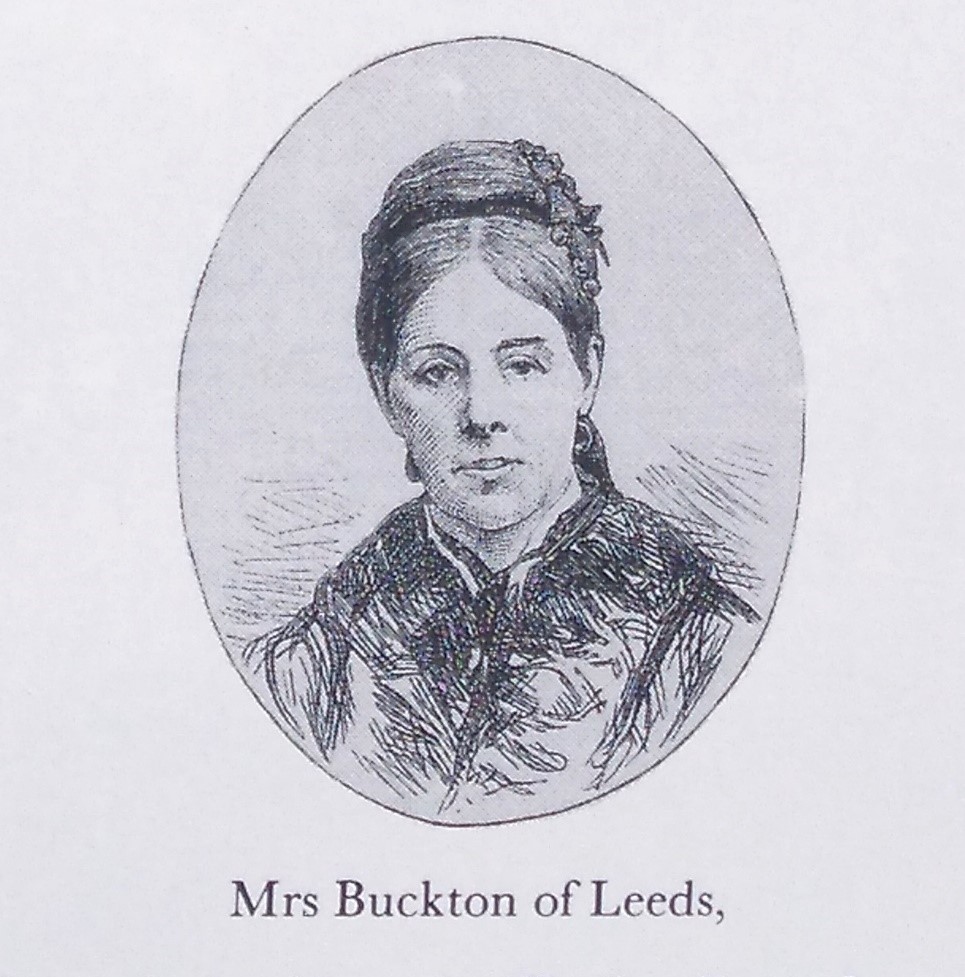Catherine Buckton
You can read more about Catherine Buckton here. Mrs Buckton was very involved with the School Boards - read more about them here.
 Catherine Buckton was born in 1827, one of nine children. Her Welsh father was a surgeon specialising in the treatment of cholera and a pioneer of public health reform. In 1848, she married Joseph Buckton, a successful cloth merchant in Leeds. They lived at 4 Blenheim Terrace, now demolished, then at 1 Moorland Terrace, overlooking Woodhouse Moor. They had two children.
Catherine Buckton was born in 1827, one of nine children. Her Welsh father was a surgeon specialising in the treatment of cholera and a pioneer of public health reform. In 1848, she married Joseph Buckton, a successful cloth merchant in Leeds. They lived at 4 Blenheim Terrace, now demolished, then at 1 Moorland Terrace, overlooking Woodhouse Moor. They had two children.
Catherine & Joseph were prominent in many local social and educational initiatives. Catherine met Lucy Wilson through an initiative to make University Extension lectures available to women. At the first elections to the new School Boards in 1869, they mounted a joint campaign as non-party candidates but neither was successful.
Catherine became Secretary to the newly established Leeds Suffrage Society in 1871 but she also volunteered to provide classes "explanatory of the laws of health to working women." The classes proved very popular. Attendance grew quickly until she was regularly attracting audiences of over 100 women. After she was invited to lecture at Saltaire, where there were even larger audiences, Queen Victoria’s daughter wrote from Germany for advice. So, in October 1873, she published a report on her work. It was republished 3 times in as many months.
In November 1873, she stood again in the School Board elections, this time as a Liberal, and came second in the poll. The workload for a committed Board member was considerable, involving 2 or 3 meetings each week and a heavy schedule of organised and unannounced school visits, so Catherine felt it necessary to resign from all her other public commitments to concentrate on this new role.
As the only woman on the Board, it was taken for granted that she would assume responsibility for the education of girls. She served on all the Committees except Finance. In her first 3 years she attended 34 out of 38 Board meetings and 83 committee meetings.
From the beginning, she refused to be intimidated by the fact that she was the only woman on the Board. She engaged fully with educational policy, emerging as a vigorous advocate for free education and persuading her colleagues to reduce school fees but the Board of Education overturned the decision. School fees were not abolished until 1891.
For two years Catherine taught voluntary lessons in Cookery and Health & Sanitation. She provided the ingredients and the poorest pupils were allowed to buy the finished dishes at cost to take home.
In 1876, the Board of Education formally adopted Domestic Science to the curriculum. Catherine designed the syllabus - including detailed lesson plans - which she published as "A Cookery Scheme for Day Schools".
The School Board was now able to appoint full-time teachers of the subject. However there was a shortage of trained women teachers. Catherine had retained her connections with the Yorkshire School of Cookery after it opened in 1874 (now part of Leeds Beckett University). She now brokered a deal whereby the School Board and the School of Cookery jointly offered teacher training, then employed the newly qualified teachers. She arranged scholarships at the School of Cookery for the ablest Board School girls - unlocking a wealth of new career opportunities in what are now termed HR, Health & Safety and Trading Standards.
She also brought her love of nature into the classroom, introducing the study of botany and nature rambles. She provided pots, soil and seeds, encouraging children from urban slums who had rarely seen a blade of grass to learn the pleasure of growing things. There were annual gardening competitions with prizes. One year over a thousand window box entries went on public displayed.
By 1876 she had proved herself hard working and highly competent, recognised as an astute politician. The Liberals recognised her value. She wrote their Election manifesto for the School Board elections that year and made the majority of keynote speeches. The Liberals were returned with her at the top of the poll. Now the Board could plan beyond mere numbers. Pupils had begun to differentiate themselves into groups with different needs so, for example, separate schools were provided for the blind, the deaf and those with special needs. A teacher training scheme was offered. Catherine was at the forefront of all these initiatives and more.
By the 1879 elections Catherine was so overworked she begged for another woman to help her. Her friend, Alice Cliff Scatcherd, offered to stand but the Liberals declined to support her. The Tories regained the majority and Mrs Buckton found herself the leader of the minority.
In 1881 her husband decided to retire from business and move to London. Her parting gift to the Liberals was a 51 page Sketch of the Elementary Education Question and the Work of the Leeds School Board. The Liberals adopted it as their Manifesto for the 1882 election and were resoundingly returned to power – without her.
Catherine published one further book, Comfort and Cleanliness, in 1894. She died in London in 1904 and her sister established a scholarship in her name for women students in Cardiff.